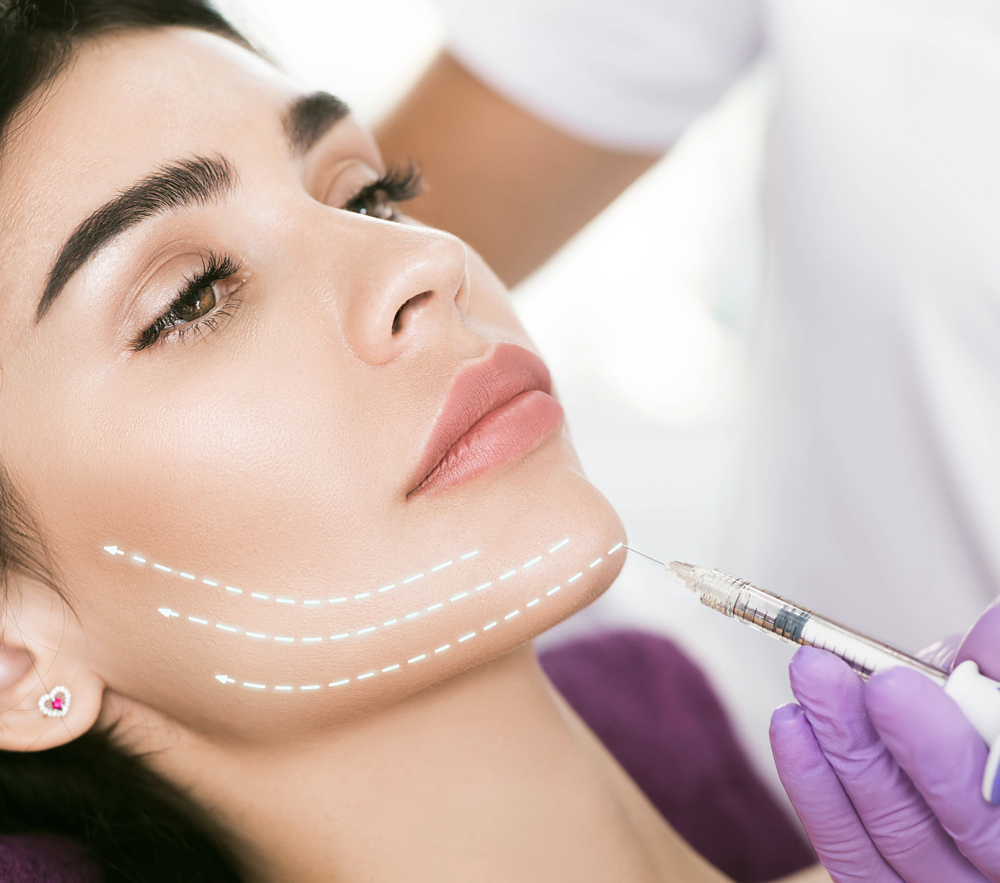Discover the Secret to Youthful Skin With
Facelift Surgery in Riyadh
Say Goodbye to Aging Skin!
As we age, our skin loses its elasticity, leading to sagging and wrinkles. One way to combat these signs of aging is through a facelift, also known as rhytidectomy. A facelift is a surgical procedure that can help improve the appearance of the face and neck, by tightening loose skin and reducing the appearance of wrinkles.
At the same time, a facelift is a major decision that requires careful consideration, planning, and preparation. It involves a surgical procedure that carries potential risks and side effects. In this article, we will discuss what a facelift is, how it works, and what you should know before, during, and after the procedure. We will also provide some tips and guidelines on how to choose a best cosmetic surgery clinic in Riyadh and what to expect during the recovery process.
Procedure Time
02 - 06 Hours
Downtime
2 - 4 Weeks
Back to Work
10 - 15 Days
Results
1 - 3 Months
What is a Facelift?
A facelift is a cosmetic surgical procedure that involves lifting and tightening the skin of the face and neck to create a smoother, more youthful appearance. It can be performed on men and women of any age, but is typically done on people over the age of 40.
During a facelift, the surgeon will make incisions in the skin around the ears and hairline, then lift and reposition the skin and underlying tissues. They may also remove excess fat and tighten the underlying muscles. Once the skin is re-draped and excess skin is removed, the incisions will be closed with sutures.
Types of Facelift
There are several types of facelifts, including:
- Traditional facelift: In this procedure, incisions are made in the hairline, around the ears, and sometimes under the chin to lift and tighten the skin and muscles of the face and neck.
- Mini facelift: This is a less invasive procedure that targets specific areas of the face, such as the lower face and jowls, and involves shorter incisions and a shorter recovery time.
- Mid facelift: This procedure focuses on the middle area of the face, including the cheeks and under the eyes, to lift and smooth out sagging skin and wrinkles.
- Thread facelift: This non-surgical procedure involves inserting threads under the skin to lift and tighten sagging areas of the face.
- S-lift: A type of mini facelift that involves making incisions in the shape of an S to lift and tighten the skin and muscles of the lower face and neck.
- Deep plane facelift: A more complex surgical procedure that involves deeper incisions and repositioning of the underlying tissues to achieve a more dramatic lifting effect.
- It’s important to consult with a qualified and experienced plastic surgeon to determine which type of facelift is best suited to your individual needs and goals.
What to Expect before the Procedure
Before you undergo a facelift, you will need to have a consultation with a qualified surgeon. During this consultation, the surgeon will evaluate your skin and facial structure, discuss your goals and expectations, and explain the procedure in detail. They may also take photographs and provide you with information on how to prepare for the procedure.
Some general tips for preparing for a facelift include:
- Quit smoking at least two weeks before the procedure.
- Avoid taking blood-thinning medications and supplements, such as aspirin and vitamin E, for at least two weeks before the procedure.
- Arrange for transportation to and from the surgical center, as well as for someone to stay with you for at least the first night after the procedure.
- Follow any other instructions provided by your surgeon.
What to Expect During the Procedure

A facelift is typically performed on an outpatient basis, meaning you will go home the same day as the procedure. The procedure may take several hours, depending on the extent of the surgery.
During the procedure, you will be given anesthesia to ensure that you are comfortable and pain-free. The specific type of anesthesia used will depend on the recommendations of your surgeon.
Once the anesthesia has taken effect, the surgeon will make incisions in the skin, lift and reposition the underlying tissues, and remove any excess skin.
They may also use liposuction to remove excess fat. Once the procedure is complete, the incisions will be closed with sutures.
What to Expect After Facelift?
After a facelift, you can expect the following:
- Swelling and bruising: It is common to experience swelling and bruising in the face and neck area, which typically peaks 2-3 days after the surgery and then gradually subsides over the next few weeks.
- Discomfort: You may experience some discomfort, such as tightness or a pulling sensation in the face and neck area, which can be managed with pain medication.
- Bandages and dressings: Your surgeon will likely apply bandages and dressings to protect the incision sites and help minimize swelling.
- Limited physical activity: You will need to avoid strenuous physical activity and lifting heavy objects for a few weeks after the surgery to allow the body to heal properly.
- Follow-up appointments: You will need to attend follow-up appointments with your surgeon to monitor the healing process and remove any stitches or staples.
- Final results: It may take several weeks to see the full results of the facelift, as the swelling and bruising gradually subside and the skin settles into its new position.
- Potential risks: As with any surgery, there are potential risks and complications associated with facelifts, including infection, bleeding, and scarring, which your surgeon will discuss with you prior to the procedure.
Age Gracefully with a Facelift - Book Your Spot Today at Enfield Royal Clinic Saudia !
After Care Tips
- Do not touch or rub the incision sites or face for at least 48 hours after the surgery.
- Avoid strenuous activities and heavy lifting for the first week after surgery.
- Do not smoke or be exposed to second-hand smoke.
- Do not drink alcohol for at least 48 hours after the surgery.
- Avoid blood-thinning medications or supplements unless approved by your surgeon.
- Protect your face from the sun and wear sunscreen with SPF 30.
- Do not apply makeup or skincare products until incisions have fully healed.
- Sleep with your head elevated and do not sleep on your face or side.
- Follow up with your surgeon and report any unusual symptoms promptly.
Benefits of Facelift
- A more youthful appearance: A facelift can help reduce the signs of aging, such as wrinkles, sagging skin, and jowls, giving you a more youthful appearance.
- Improved facial contours: By tightening and lifting the skin and underlying tissues, a facelift can improve the contours of the face, creating a more defined and attractive appearance.
- Increased self-confidence: Many people report feeling more confident and self-assured after a facelift, as they are no longer self-conscious about the signs of aging on their face.
- Long-lasting results: While the results of a facelift are not permanent, they can last for several years, especially if the patient follows a healthy lifestyle and takes good care of their skin.
- Improved skin quality: Facelift surgery can help improve the overall quality of the skin, reducing the appearance of sun damage, fine lines, and age spots.
- It is important to have realistic expectations for the results of a facelift, and to understand that the outcome will depend on several factors, such as the type of facelift, the surgeon’s skill and experience, and the patient’s individual anatomy and healing process. Consulting with a qualified and experienced surgeon can help you understand the potential results of a facelift and make an informed decision about the procedure.
Cost of Facelift in Riyadh
Facelift
Starting FromFaceLift
StandardThe cost of a facelift in Riyadh can vary depending on several factors, such as the type of facelift, the surgeon’s experience and qualifications, and the clinic’s location and reputation. On average, facelift can cost between SAR 32,000 and SAR 40,000 (USD 8,000 to USD 12,000).
How to Choose the Best Plastic Surgery Clinic in Riyadh
Choosing the best plastic surgery clinic in Riyadh can be a daunting task. Here are some tips to help you find the right clinic for your needs:
- Look for qualified and experienced practitioners: It is important to choose a clinic with qualified and experienced practitioners who have specialized training in facial plastic surgery. Check the credentials and experience of the surgeon who will perform the procedure.
- Check the type of facelift techniques offered: Different clinics may use different types of facelift techniques. Research the various techniques, such as traditional facelifts, mini facelifts, and thread facelifts, to determine which one is best suited to your needs.
- Read online reviews and testimonials: Look for online reviews and testimonials from previous patients to get an idea of their experiences with the clinic and the quality of care they received.
- Consider the facilities and equipment: The facilities and equipment at the clinic should be modern and up-to-date. Make sure that the clinic has a sterile environment and that they follow proper safety and hygiene protocols.
- Check the pricing and financing options: Facelift procedures can be costly, so it is important to choose a clinic that offers fair and transparent pricing. Look for a clinic that offers financing options, such as payment plans or medical financing.
- By considering these factors, you can choose the best facelift clinic in Riyadh that meets your needs and gives you the results you desire.
Why Choose Us
At Enfield Royal Saudia, we are dedicated to providing our patients with high-quality cosmetic care that is both effective and affordable. Here’s why we believe you should choose us for your Facelift surgery needs,
- Experienced and Highly Trained Dermatologists
- State-of-the-Art Facilities
- Affordable and Cost-Effective
- Patient-Focused Care
- Commitment to Excellence
We believe that these factors set us apart from other cosmetic clinics in Riyadh, Saudi Arabia, and make Enfield Royal Saudia the best choice for your Facelift Treatment needs. Contact us today to learn more about our services and schedule your appointment.
FAQs.
The best candidates for a facelift are individuals who are in good overall health, with realistic expectations for the procedure. The surgeon will evaluate your skin quality, facial structure, and other factors to determine if you are a good candidate for the procedure.
The recovery process after a facelift can vary depending on the individual and the type of facelift performed. Most patients can expect some swelling, bruising, and discomfort for several days to weeks after the surgery. The surgeon will provide instructions on post-operative care and follow-up appointments.
The results of a facelift can last for several years, but the duration of the results will depend on factors such as the type of facelift, the patient’s individual anatomy, and their lifestyle habits.
Like all surgical procedures, a facelift does carry some risks, such as infection, bleeding, and scarring. The surgeon will discuss potential risks and complications with you prior to the procedure.
Yes, there are non-surgical alternatives to a facelift, such as injectables like Botox or dermal fillers, or non-invasive treatments like laser resurfacing or ultrasound therapy. These options can provide some improvement in the appearance of the face, but they may not provide the same level of results as a surgical facelift.
Relevant Treatments.

Non-Surgical Facelift solutions
If surgery isn’t right for you, are you seeking a non-surgical way to restore your youthful appearance? You could find that nonsurgical facelifts are the best option for you! With a variety of minimally invasive procedures, you can get rid of wrinkles, tighten sagging skin, and look younger without the hazards or recovery time of standard facelift surgery. In this post, we’ll examine the advantages of both surgical and nonsurgical facelifts,

Vampire Facelift
Your facial apprentice is the main key element of your personality. By aging your face gains some wrinkles and poor skin texture causing you to look old. If you are suffering from facial uncleanliness due to aging or any other skin disorder then our clinic is offering you Vampire Facelift in Riyadh that helps you achieve ideal facial skin. The Vampire Facelift is a minimally invasive procedure and is typically well-tolerated by patients. This innovative
Relevant Treatments.

Vampire Facelift Cost in Riyadh
Have you ever wished you could go back in time and experience your childhood again? A fascinating trend where innovation and the pursuit of beauty gather up is the vampire facelift.? Come along with us as we explore the Vampire Facelift in Riyadh. Learn More about it. Using the patient’s blood to revitalize the face, a vampire facelift, also called a platelet-rich plasma (PRP) facelift, is a cosmetic treatment. Because the patient’s blood is used during the treatment, the word “vampire” is frequently linked to it.

